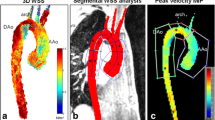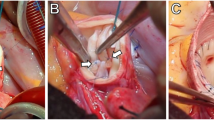Abstract
Background
Children with bicuspid aortic valve (BAV) are at risk for serious complications including aortic valve stenosis and aortic rupture. Most studies investigating biomarkers predictive of BAV complications are focused on adults.
Objective
To investigate whether hemodynamic parameters change over time in children and young adults with BAV by comparing baseline and follow-up four-dimensional (4-D) flow MRI examinations.
Materials and methods
We retrospectively included 19 children and young adults with BAV who had serial 4-D flow MRI exams (mean difference in scan dates 1.8±1.0 [range, 0.6–3.4 years]). We compared aortic peak blood flow velocity, three-dimensional (3-D) wall shear stress, aortic root and ascending aortic (AAo) z-scores between baseline and follow-up exams. We generated systolic streamlines for all patients and visually compared their baseline and follow-up exams.
Results
The only significant difference between baseline and follow-up exams occurred in AAo z-scores (3.12±2.62 vs. 3.59±2.76, P<0.05) indicating growth of the AAo out of proportion to somatic growth. There were no significant changes in either peak velocity or 3-D wall shear stress between baseline and follow-up exams. Ascending aortic peak velocity at baseline correlated with annual change in AAo z-score (r=0.58, P=0.009). Visual assessment revealed abnormal blood flow patterns, which were unique to each patient and remained stable between baseline and follow-up exams.
Conclusion
In our pediatric and young adult BAV cohort, hemodynamic markers and systolic blood flow patterns remained stable over short-term follow-up despite significant AAo growth, suggesting minimal acute disease progression. Baseline AAo peak velocity was a predictor of AAo dilation and might help in determining pediatric patients with BAV who are at risk of increased AAo growth.




Similar content being viewed by others
References
Siu SC, Silversides CK (2010) Bicuspid aortic valve disease. J Am Coll Cardiol 55:2789–2800
Subramanian R, Olson LJ, Edwards WD (1984) Surgical pathology of pure aortic stenosis: a study of 374 cases. Mayo Clin Proc 59:683–690
Michelena HI, Khanna AD, Mahoney D et al (2011) Incidence of aortic complications in patients with bicuspid aortic valves. JAMA 306:1104–1112
Sabet HY, Edwards WD, Tazelaar HD et al (1999) Congenitally bicuspid aortic valves: a surgical pathology study of 542 cases (1991 through 1996) and a literature review of 2,715 additional cases. Mayo Clin Proc 74:14–26
Larson EW, Edwards WD (1984) Risk factors for aortic dissection: a necropsy study of 161 cases. Am J Cardiol 53:849–855
Roberts CS, Roberts WC (1991) Dissection of the aorta associated with congenital malformation of the aortic valve. J Am Coll Cardiol 17:712–716
Verma S, Siu SC (2014) Aortic dilatation in patients with bicuspid aortic valve. N Engl J Med 370:1920–1929
Ward C (2000) Clinical significance of the bicuspid aortic valve. Heart 83:81–85
Michelena HI, Desjardins VA, Avierinos JF et al (2008) Natural history of asymptomatic patients with normally functioning or minimally dysfunctional bicuspid aortic valve in the community. Circulation 117:2776–2784
Bissell MM, Hess AT, Biasiolli L et al (2013) Aortic dilation in bicuspid aortic valve disease: flow pattern is a major contributor and differs with valve fusion type. Circ Cardiovasc Imaging 6:499–507
Girdauskas E, Disha K, Borger MA et al (2012) Relation of bicuspid aortic valve morphology to the dilatation pattern of the proximal aorta: focus on the transvalvular flow. Cardiol Res Pract 2012:478259
Holmes KW, Lehmann CU, Dalal D et al (2007) Progressive dilation of the ascending aorta in children with isolated bicuspid aortic valve. Am J Cardiol 99:978–983
Pees C, Michel-Behnke I (2012) Morphology of the bicuspid aortic valve and elasticity of the adjacent aorta in children. Am J Cardiol 110:1354–1360
Potters WV, van Ooij P, Marquering H et al (2015) Volumetric arterial wall shear stress calculation based on cine phase contrast MRI. J Magn Reson Imaging 41:505–516
Mahadevia R, Barker AJ, Schnell S et al (2014) Bicuspid aortic cusp fusion morphology alters aortic three-dimensional outflow patterns, wall shear stress, and expression of aortopathy. Circulation 129:673–682
Guzzardi DG, Barker AJ, van Ooij P et al (2015) Valve-related hemodynamics mediate human bicuspid aortopathy: insights from wall shear stress mapping. J Am Coll Cardiol 66:892–900
Dore A, Brochu MC, Baril JF et al (2003) Progressive dilation of the diameter of the aortic root in adults with a bicuspid aortic valve. Cardiol Young 13:526–531
Ferencik M, Pape LA (2003) Changes in size of ascending aorta and aortic valve function with time in patients with congenitally bicuspid aortic valves. Am J Cardiol 92:43–46
Nistri S, Sorbo MD, Marin M et al (1999) Aortic root dilatation in young men with normally functioning bicuspid aortic valves. Heart 82:19–22
Warren AE, Boyd ML, O'Connell C et al (2006) Dilatation of the ascending aorta in paediatric patients with bicuspid aortic valve: frequency, rate of progression and risk factors. Heart 92:1496–1500
Spaziani G, Ballo P, Favilli S et al (2014) Clinical outcome, valve dysfunction, and progressive aortic dilation in a pediatric population with isolated bicuspid aortic valve. Pediatr Cardiol 35:803–809
Sievers HH, Schmidtke C (2007) A classification system for the bicuspid aortic valve from 304 surgical specimens. J Thorac Cardiovasc Surg 133:1226–1233
Markl M, Harloff A, Bley TA et al (2007) Time-resolved 3D MR velocity mapping at 3T: improved navigator-gated assessment of vascular anatomy and blood flow. J Magn Reson Imaging 25:824–831
Bock J, Kreher B, Hennig J, Markl M (2007) Optimized pre-processing of time-resolved 2D and 3D phase contrast MRI data. The 15th annual meeting of ISMRM, Berlin, Germany
Rose MJ, Jarvis K, Chowdhary V et al (2016) Efficient method for volumetric assessment of peak blood flow velocity using 4D flow MRI. J Magn Reson Imaging 44:1673–1682
Nishimura RA, Otto CM, Bonow RO et al (2014) 2014 AHA/ACC guideline for the management of patients with valvular heart disease: executive summary: a report of the American College of Cardiology/American Heart Association task force on practice guidelines. J Am Coll Cardiol 63:2438–2488
van Ooij P, Powell AL, Potters WV et al (2016) Reproducibility and interobserver variability of systolic blood flow velocity and 3D wall shear stress derived from 4D flow MRI in the healthy aorta. J Magn Reson Imaging 43:236–248
Burk J, Blanke P, Stankovic Z et al (2012) Evaluation of 3D blood flow patterns and wall shear stress in the normal and dilated thoracic aorta using flow-sensitive 4D CMR. J Cardiovasc Magn Reson 14:84
Allen BD, van Ooij P, Barker AJ et al (2015) Thoracic aorta 3D hemodynamics in pediatric and young adult patients with bicuspid aortic valve. J Magn Reson Imaging 42:954–963
Hope MD, Hope TA, Meadows AK et al (2010) Bicuspid aortic valve: four-dimensional MR evaluation of ascending aortic systolic flow patterns. Radiology 255:53–61
De Hert SG (2006) Volatile anesthetics and cardiac function. Semin Cardiothorac Vasc Anesth 10:33–42
Acknowledgments
We thank Marci Messina, RT(R)(MR), for scanning and Ryan Kuhn, Sebastian Garcia and Paige Nelson for data collection and patient consent. This work was supported by National Institutes of Health grants R01 HL115828 and K25 HL119608, and American Heart Association Midwest Affiliate grants 6POST27250158 and 16SDG30420005.
Author information
Authors and Affiliations
Corresponding author
Ethics declarations
Conflicts of interest
None
Rights and permissions
About this article
Cite this article
Rose, M.J., Rigsby, C.K., Berhane, H. et al. 4-D flow MRI aortic 3-D hemodynamics and wall shear stress remain stable over short-term follow-up in pediatric and young adult patients with bicuspid aortic valve. Pediatr Radiol 49, 57–67 (2019). https://doi.org/10.1007/s00247-018-4257-y
Received:
Revised:
Accepted:
Published:
Issue Date:
DOI: https://doi.org/10.1007/s00247-018-4257-y




